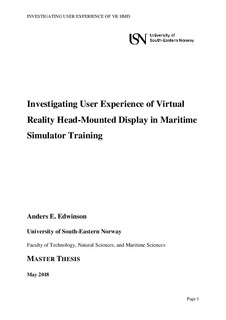Investigating User Experience of Virtual Reality Head-Mounted Display in Maritime Simulator Training
Master thesis
Permanent lenke
http://hdl.handle.net/11250/2638048Utgivelsesdato
2018Metadata
Vis full innførselSamlinger
Sammendrag
The implementation of new technology in education is an unceasing process. For implementing such technologies, evidence of its positive effect needs to be validated. A popular method for evaluating a product is through User Experience testing. How well the user perceives a product has a connection to its effect. This research aims to expand the knowledge base within the maritime simulator domain through User Experience (UX) testing of a virtual reality (VR) head-mounted display (HMD) compared to a traditional desktop computer configuration. The primary focus for this research is to investigate the potential of using a head-mounted VR device in maritime simulator training and contribute to the growing body of knowledge interested in answering: Will VR HMDs provide a better user experience than a traditional desktop computer configuration?
A between-subjects experimental design was implemented to compare participants (N=50) between two different conditions: VR and Desktop configurations, each scored by a UX questionnaire. Three out of six dimensions showed a significant difference in favour of VR (Attractiveness, Stimulation, and Novelty). Thus, the positive potential for using a VR HMD for maritime simulator training is deemed to be strong. There are positive consequences for implementing VR HMDs as educational tools. Attractiveness improves the desire to use the tool more often and therefore increases the amount of training.
